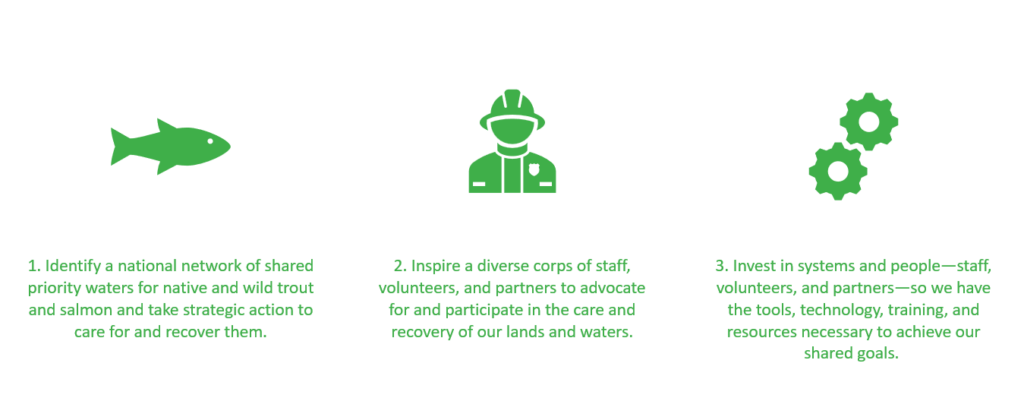TU Council Strategic Planning Resources and Templates
Strategic planning is a vital tool for TU councils in order to make a meaningful impact on watersheds and communities in your state. Strategic planning will helps your council to:
– Clarify your council’s purpose and long-term goals.
– Identify clear, achievable short-term goals and objectives.
– Allocate resources effectively.
– Align state and local efforts with TU’s national priorities and priority waters.
– Engage volunteers, partners and communities more effectively.
– Measure and communicate your successes.
The strategic planning process offers volunteer leaders a rare opportunity to pause and look at the council as a whole and develop, as a collective, a concrete vision of the impact the council intends to make over the next few years. It is a time to connect the dots between mission and programs, to specify the resources that will be required to deliver those programs, and to establish criteria that allow everyone to understand whether the desired results were achieved.

Strategic Planning Resources
Ready to get started on your council’s plan? This simple, step-by-step guide may help:
- Get organized.
The council chair should convene a small workgroup or committee. Not all strategic planning committee members need to be current board members, i.e. Your committee may benefit from thoughtfully populating your group with diverse chapter representation as well as up and coming chapter and council leaders. A chair of the committee should be identified so that it is clear who is responsible for facilitating meetings, identifying action items, giving direction and following through. - Evaluate where you are.
If revising a plan, Analyze successes and areas for improvement under the current plan. What goals were achieved? Where did challenges arise? Collect feedback from council members, chapter leaders, volunteers, and partners. If starting fresh, identify available human resources, funding, partnerships, and local opportunities. Understand current conservation priorities, emerging issues, and community needs.
Consider running a SWOT assessment by collecting feedback from your chapter leaders, members, partners, and regionally based staff about the council’s internal strengths and weaknesses, and also your external opportunities and threats. Surveys are a good tool for gathering this information, but so too are simple conversations. As you go through, it’s not enough to ask, “What is our council’s biggest weakness?” you have to go a step further and say, “Why have we neglected this area?” It also helps to think of your strengths as opportunities for growth. “We have great engagement on social media, but how can we move a higher percentage of those supporters to donate or volunteer? Gathering outside perspective can be incredibly helpful. - Align with TU’s Priority Waters.
TU’s Priority Waters framework identifies critical rivers, streams, and watersheds that are central to our conservation mission. State councils play a vital role in identifying and supporting conservation in these places. Collaborate with TU staff and scientists to ensure your strategic plan reflects science-based priorities while also addressing the needs and aspirations of your council and chapters. - Visioning: think big picture.
The visioning phase is your opportunity to dream big while staying grounded in reality. Bring your council’s board of directors together to envision what success looks like in 3-5 years. Ask big questions, like: “How can we best contribute to TU’s mission in our state?” Use TU’s scientific resources and local expertise to ground your vision in evidence-based priorities. - Set goals and priorities.
Define the specific goals your council will focus on during the strategic planning period. Ensure the goals are Specific, Measurable, Achievable, Relevant, and Time-bound (SMART.) Consider the resources at your disposal and what your board is realistically able to achieve. Goals should include both on-the-ground conservation work (e.g., habitat restoration) and community-building efforts (e.g., volunteer recruitment or youth education). Common organizing frames for council strategic plans are around “Protect, Reconnect, Restore and Sustain” and “Conservation, Communications, Engagement, Fundraising, Chapter Development, and Council Development.” - Create an implementation plan.
Once the strategic goals are defined, create an implementation plan that outlines:
• Roles and Responsibilities: Clarify who will lead each initiative.
• Timelines: Establish clear deadlines for milestones and deliverables.
• Budget: Align financial resources with your strategic goals.
The chair of the strategic planning committee takes the draft written by committee and cleans it up into a short, clean and compelling piece. - Collaborate across TU’s network.
Remember that your council is part of a much larger organization that includes hundreds of chapters, dozens of councils, and over 350 national staff. Leverage TU’s resources, expertise, and partnerships to enhance your impact. Foster collaboration with chapters and councils in neighboring states to tackle shared priorities. Seek guidance and support from TU’s regional engagement managers and other staff. - Embrace flexibility and accountability.
Strategic plans are not static documents. Schedule regular check-ins to assess progress and adjust as needed and as circumstances change – they will. Celebrate wins and address challenges as a team. - Finalize and share your plan.
Ensure your strategic plan is clear, actionable, and well-communicated. Share the plan with TU staff, chapters, volunteers, and partners. Highlight how it aligns with TU’s mission and Priority Waters. A well-crafted strategic plan not only drives conservation outcomes but also inspires your community to get involved.
Strategic planning is both an art and a science. By thinking big, grounding your efforts in TU’s mission and science, and building on the strengths of your council and community, you can create a plan that makes a lasting impact on rivers and streams—and the people who care for them. Here are a few additional resources to help you on your strategic planning journey.
Read: Trout Unlimited Strategic Plan
Your council’s strategic plan should follow the mission and goals of Trout Unlimited’s national plan, but with a focus on the issues and resources in your council geography. You should also check with your chapters to review and better understand their strategic plans, focusing attention on specific goals or trends that your team may incorporate.
Reach Out: Contact the Volunteer Operations staff and they can work with you to cover the ins and outs of chapter strategic planning and offers helpful tips and guidance that is also applicable to council strategic planning.
Watch: Using Data to Drive Strategy
This one-hour recorded training reviews how you can use your chapters’ Annual Activity Report and other data to develop aspects of your plan.
Use: The Strategic Planning Template
This document can be used as a guide, or just as a starting point to help organize your strategic planning process.


